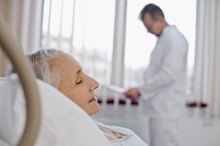How to Treat Gas Pain After Laparoscopic Gallbladder Surgery
Gallbladder removal, or cholecystectomy, is the most common abdominal surgery in the U.S. The procedure is most often performed in people who have experienced one or more gallbladder attacks. With a laparoscopic cholecystectomy, the surgeon makes 1 to 4 small incisions in the abdomen into which hollow tubes called ports are placed. A tiny, lighted camera and surgical instruments are passed through the ports that enable the surgeon to remove the gallbladder. Carbon dioxide gas is pumped into the abdomen during the procedure to allow the surgeon to better visualize the gallbladder and other abdominal organs. Most of this gas is removed from the abdomen at the end of the procedure but some remains and may cause pain after surgery. Constipation can also cause gas pain after laparoscopic gallbladder surgery.
If you are experiencing serious medical symptoms, seek emergency treatment immediately.
Lie on Your Side or Back
Pain due to residual carbon dioxide gas in your abdomen is usually worst during the first 24 to 48 hours after a laparoscopic cholecystectomy. You might experience this gas-related pain in your abdomen or shoulder, as the gas tends to collect beneath and irritate your diaphragm when you are upright. Lying on your left side with your right knee bent in front of you can help relieve the pain. Other people find lying flat on your back with a pillow beneath your knees eases the pain.
- Pain due to residual carbon dioxide gas in your abdomen is usually worst during the first 24 to 48 hours after a laparoscopic cholecystectomy.
- Other people find lying flat on your back with a pillow beneath your knees eases the pain.
Walk
Diet to Reduce Constipation & Gas
Learn More
Getting up and walking as soon as your healthcare team allows you to do so can help ease gas pains after a laparoscopic cholecystectomy. The surgery temporarily halts the normal muscular contractions of your intestines, which can lead to gas pains and bloating. Walking encourages your bowels to resume their normal activity, moving through gas and stool. Begin slowly and work up to your usual activity level, which typically takes 1 to 3 weeks.
- Getting up and walking as soon as your healthcare team allows you to do so can help ease gas pains after a laparoscopic cholecystectomy.
- The surgery temporarily halts the normal muscular contractions of your intestines, which can lead to gas pains and bloating.
Drink Plenty of Water
The American College of Surgeons recommends that you drink 8 to 10 glasses of water daily after gallbladder removal 1. This encourages normal bowel function and reduces the likelihood of developing constipation. Warm beverages are a better choice than cold ones as warm fluids promote intestinal activity. Avoid carbonated drinks, which can make gas pains and bloating worse.
- The American College of Surgeons recommends that you drink 8 to 10 glasses of water daily after gallbladder removal 1.
- Avoid carbonated drinks, which can make gas pains and bloating worse.
Eat a High-Fiber Diet
How to Get Gas Relief After Colonoscopy
Learn More
You can return to eating a regular diet as soon as you're able to keep down clear fluids. A high-fiber diet with plenty of fruits, vegetables and whole grains will help you start passing stool more quickly and prevent constipation with related gas pains. Your doctor might recommend a stool softener so you don't strain while having a bowel movement. Avoid fatty foods, which slow digestion and may promote constipation and associated gas pain.
- You can return to eating a regular diet as soon as you're able to keep down clear fluids.
- A high-fiber diet with plenty of fruits, vegetables and whole grains will help you start passing stool more quickly and prevent constipation with related gas pains.
Other Considerations
To avoid introducing more air into your digestive system, avoid smoking, chewing gum and using a straw to drink beverages. Your doctor may prescribed a narcotic pain-reliever after surgery, but it's best to use this medication only as needed because narcotics slow the digestive system and can contribute to constipation and gas pain.
Warnings and Precautions
Gas pains after laparoscopic gallbladder removal usually decrease substantially within 48 hours after surgery with continued improvement in the following days. While some pain after a cholecystectomy is expected, persistent or severe pain may signal a possible complication. Contact your surgeon immediately if you experience any warning signs and symptoms, including:
- Severe or worsening abdominal pain
- Fever higher than 101 F
- Increasing abdominal bloating
- No bowel movement within 72 hours after surgery
- Inability to keep down fluids
- Drainage from one or more of your incisions
- Yellowing of your skin or the whites of your eyes
Reviewed and revised by: Tina M. St. John, M.D.
- Gas pains after laparoscopic gallbladder removal usually decrease substantially within 48 hours after surgery with continued improvement in the following days.
- While some pain after a cholecystectomy is expected, persistent or severe pain may signal a possible complication.
Related Articles
References
- American College of Surgeons: Cholecystectomy
- Ohio State University Medical Center: How to Get Rid of Gas After Surgery
- Society of American Gastrointestinal and Endoscopic Surgeons: Guidelines for the Clinical Application of Laparoscopic Biliary Tract Surgery
- Journal of Long-Term Effects of Medical Implants: Cholelithiasis and Cholecystitis
- Anesthesiology and Pain Medicine: Residual Pneumoperitoneum Volume and Postlaparoscopic Cholecystectomy Pain
- Gomes CA, Junior CS, et al. Acute calculous cholecystitis: Review of current best practices. World J Gastrointest Surg. 2017;9(5):118-126. doi:10.4240/v9i5118
- Victoria State Government. Better Health Channel. Gallbladder-gallstones and surgery. Updated August 2014.
- Sages. Gallbladder removal surgery (cholescystectomy) patient information from Sages. Updated April 3, 2019.
- ASCRS. Laparoscopic Surgery-What is it? Updated 2020.
- Grau-talens EJ, Motos-micó JJ, Giraldo-rubio R, et al. Small-incision cholecystectomy (through a cylinder retractor) under local anaesthesia and sedation: a prospective observational study of five hundred consecutive cases. Langenbecks Arch Surg. 2018;403(6):733-740. doi:10.1007/s00423-018-1707-9
- Fisichella PM, Demeester SR, Hungness E, et al. Emerging techniques in minimally invasive surgery. Pros and cons. J Gastrointest Surg. 2015;19(7):1355-62. doi:10.1007/s11605-015-2766-7
- MedlinePlus. Open gallbladder removal. Updated April 9, 2020.
- Cleveland Clinic. Laparoscopic cholecystectomy (gallbladder removal): Risks / benefits. Updated 2020.
Writer Bio
Marcy Brinkley has been writing professionally since 2007. Her work has appeared in "Chicken Soup for the Soul," "Texas Health Law Reporter" and the "State Bar of Texas Health Law Section Report." Her degrees include a Bachelor of Science in Nursing; a Master of Business Administration; and a Doctor of Jurisprudence.








